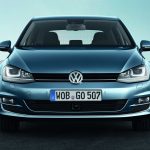
40 years of Volkswagen Golf success: what's the secret
Content
- The history of the creation and development of the Volkswagen Golf model
- First generation Golf I (1974–1983)
- Second generation Golf II (1983–1991)
- Third generation Golf III (1991–1997)
- Fourth generation Golf IV (1997–2003)
- Fifth generation Golf V (2003–2008)
- Sixth generation Golf VI (2008–2012)
- Seventh generation Golf VII (2012 - present)
- Features of models running on gasoline and diesel fuel
- Volkswagen Golf 2017
- Owner feedback
1974 is an era of significant change. At a difficult time, VW had a hard time finding a replacement for a car so popular but out of fashion: the VW Beetle. Volkswagen did not reinvent the wheel and modified the rounded car into an innovative vehicle for people. The commitment of the designers of that time to the principles of the air-cooled rear engine made it difficult to choose a future successor to the model.
The history of the creation and development of the Volkswagen Golf model
The situation in the country in the early 1970s was not easy. The Volkswagen range is outdated. The success of the Zhuk model did not attract buyers, and this was against the backdrop of new vehicle manufacturers such as Opel.
Attempts to create a model with more attractive features, front-engined and water-cooled ran into a misunderstanding from senior management due to unnecessarily high production costs. All prototypes were rejected until the new VW boss Rudolf Leiding took over. The car model was designed by Italian designer Giorgio Giugiaro. The resounding success of the compact car concept continued with the new VW Golf with its distinctive hatchback body. From the very beginning, the idea of creation was aimed at technical benefits for the entire population of the country, regardless of status and financial situation. In June 1974, Golf became the "hope" of the VW Group, which at that time was in an existential crisis.

Giugiaro gave the Golf a distinctive look by adding adjustments to the round headlight surrounds. The company's product was considered an outstanding example of front-wheel drive, water-cooled powertrain design, introducing a different concept from the Beetle.
Photo gallery: lineup timeline
-

- The angular 1974 Volkswagen Golf changed the company's predicament for the better.
-

- 1983 Golf introduces revised design with exterior and interior upgrades
-

- The angular design of the Golf is completely replaced by a smooth outline in 1991.
-

- Improved 1997 Golf appearance with soft curves becomes a bestseller
-

- Significantly increased interior space, improved aerodynamics and comfort in the 2003 Golf
-

- Updated optics and noise reduction are the main modifications of the Golf 2008
-

- Successful 2012 Golf space concept draws attention
First generation Golf I (1974–1983)
The VW Golf is a car that has set the standard for future generations by becoming the favorite vehicle of the Germans. The start of production is the departure of the first model from the production line on March 29, 1974. The first-generation Golf featured an angular design, a vertical, solid stance, wheel arches, and a bumper with a narrow grille. Volkswagen brought to the market a model that became the legend of a new generation of cars. Golf helped Volkswagen to survive, not allowing to lose prestige and maintaining the status of the company.
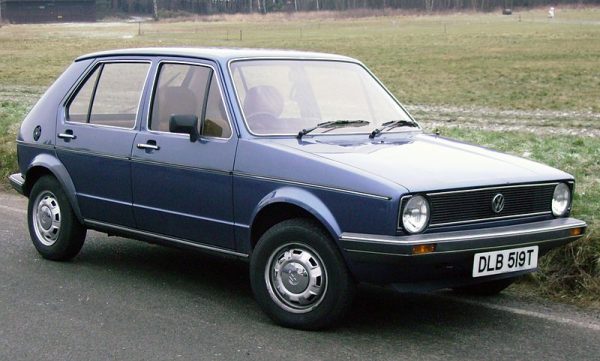
Volkswagen entered the future with an updated design concept, a large tailgate, improved aerodynamics and a bold character.
The chic design of the Golf I was so good that in 1976 it completely removed the Beetle from the throne of the German market. In the two years since the start of production, VW has produced the millionth Golf.
Video: 1974 VW Golf
Model options
The Golf has set a high bar for one-model variations for automakers:
- in 1975, a sports version of the Golf GTI appeared. She made a strong impression on the roads in the distant seventies;
- in 1976, Golf Diesel hit the other extreme: low fuel consumption of six liters and a high level of reliability;
- in 1979, the Golf Cabriolet gave great popularity to the Volkswagen brand. The model was produced unchanged until August 1993.

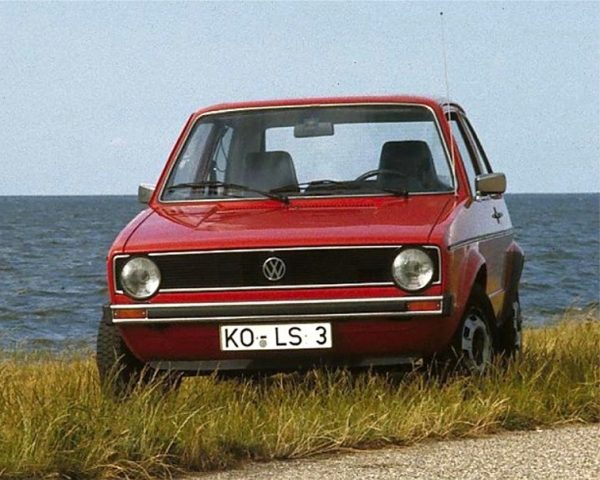 The VW Golf has been a favorite family car since 1974.
The VW Golf has been a favorite family car since 1974.
Golf proved extremely practical. The body is available in two- and four-door versions. The redesigned chassis made it possible to confidently drive vehicles at previously unimaginable speeds, carefully entering turns. Engines in 50 and 70 liters. With. worked steadily in the Beetle tradition with incredible power and moderate fuel consumption, thanks to the stylized hull's aerodynamics.
In 1975, GTI introduced a truly attractive vehicle formula: a sporty compact hatchback with a 110 hp engine. with., a volume of 1600 cubic centimeters and K-Jetronic injection. The performance of the power unit was superior to that of other compact front-wheel drive vehicles. Since then, the number of GTI fans has grown daily. Just a few months after the GTI, the Golf created a sensation: the Golf Diesel, the first diesel in the compact class.


Before starting production of the second generation Golf, Volkswagen installed a turbine on a diesel engine, and the GTI received an updated engine with a displacement of 1,8 liters and a power of 112 hp. With. The first chapter of the Golf ended with a special GTI Pirelli prototype.
Photo gallery: VW Golf I
-


- The different color scheme of the Golf attracts the general public
-


- Rectangular taillights of the first version of the Golf distinguish the model
-


- Small hatchback with a roomy and practical boot
-


- The aerodynamics of the Golf emphasized the daring character
-


- For the first time on a Volkswagen Golf model, twin headlights are used.
-


- The engine underlines the power of the sports version of the Golf
-

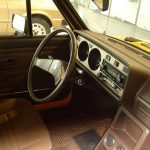
- Spartan driver placement by modern standards
-


- Practical control without unnecessary elements
-


- Comfortable interior of Volkswagen Golf with comfortable seats
Second generation Golf II (1983–1991)
The Golf II is a Volkswagen brand produced between August 1983 and December 1991. During this period, 6,3 million pieces were produced. The model, produced as a three- and five-door hatchback, completely replaced the first generation Golf. Golf II was the result of a thorough analysis of the shortcomings of the previous model, serving as the main benchmark for increasing the company's profitability.
Golf II continued the technical concept of increasing external dimensions and performance.
In the production of the Golf II, VW pioneered the use of automatically controlled industrial robots, which contributed to the great sales success and widespread use of vehicles until the early 1990s.


Video: 1983 VW Golf
Already in 1979, management approved the design of a new second-generation model, and since 1980 prototypes have been tested. In August 1983, the Golf II was presented to the public. A car with an extended wheelbase represents a large space in the cabin. Rounded body shapes with distinctive headlights and a wide side pillar retained the low drag coefficient of air, improving it to 0,34 compared to 0,42 for the predecessor model.
Since 1986, the Golf II has been equipped with all-wheel drive for the first time.


The 1983 concept has a protective anti-corrosion coating that eliminates rust problems on pre-1978 vehicles. The partially galvanized body of the Golf II model was completed with a narrow stowage in the luggage compartment instead of a full-size spare wheel. For an additional fee, a full-fledged element was provided.
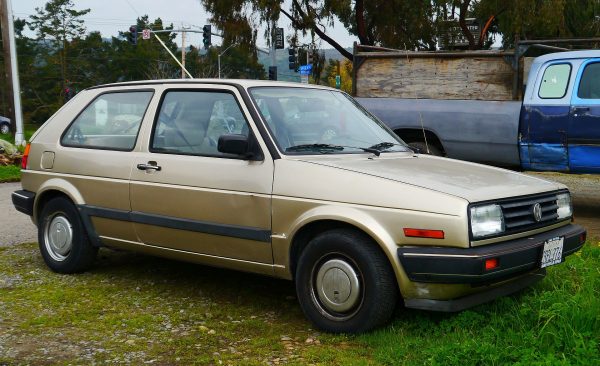

Since 1989, all models received a standard five-speed gearbox. First proposed:
- power steering;
- ABS;
- power windows;
- central locking;
- heated seats.
A key success factor was the large interior space with real leather interior trim. The updated and economical engine used modern technical solutions with a partially automatic transmission. Since 1985, engines have been equipped with a non-variable catalytic converter and exhaust gas control, complying with federal government environmental directives.
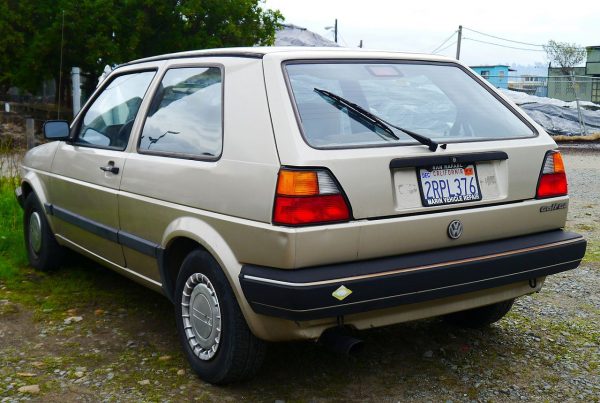

Visually, compared to its predecessor, the VW Golf 2 has not changed in the basic concept. The revised chassis offered greater suspension comfort and lower noise levels. The all-wheel drive GTI continued to impress motorists with power and decent handling, becoming an analogue of a crossover with increased ground clearance and a 210-horsepower 16V engine.
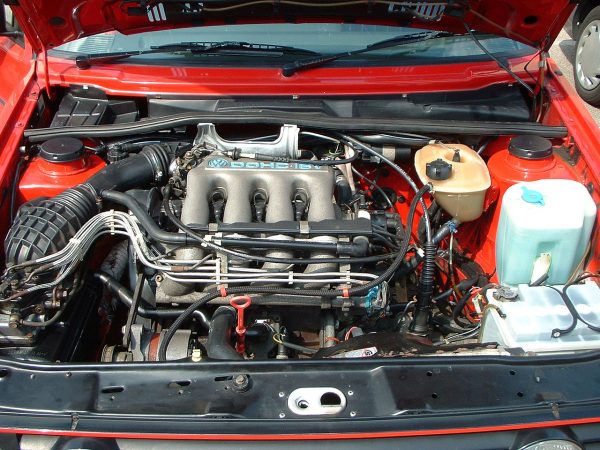

Since the release of the first model Golf has become one of the most sought-after cars in the world. Motorists purchased up to 400 cars a year.
Photo gallery: VW Golf II
-


- Recognizable features of the Golf II contributed to the sales success of the model
-


- The lack of a spacious luggage compartment does not affect the love for the model.
-


- By modern standards, the design of the Golf II is considered unprepossessing and angular.
-


- The compact and practical hatchback Golf II is in demand in the urban environment
-


- Compact model Golf II in a galvanized body has become a favorite model of motorists
-


- Family version of the Golf II with expressive twin headlights has been released outside of Germany
-


- Informative instrument panel Golf II is made at a decent level
-


- The comfortable interior of the Golf II with many additional features ensured comfortable driving
-


- The introduction of new technologies is noticeable by the number of buttons and controls
-


- VW Golf II with all-wheel drive made it possible to turn off the highway into off-road without hesitation
Third generation Golf III (1991–1997)
The third modification of the Golf visually changed the concept of the body, continuing the success story of its predecessors. Notable changes were the oval headlights and windows, which significantly improved the aerodynamics of the model to a figure of 0,30. In the compact class, VW offered a six-cylinder engine for the Golf VR6 and the first 90 hp car. With. with turbodiesel direct injection for the Golf TDI.
Video: 1991 VW Golf
From the very beginning, the Golf III represented a model with seven engine options. The tight dimensions of the engine compartment made it possible to arrange cylinders in the VR design with 174 hp. With. and a volume of 2,8 liters.
In addition to power, engineers sought to improve the reliability of the model, using airbags for the driver and passenger, and then integrated side airbags for the front seats.
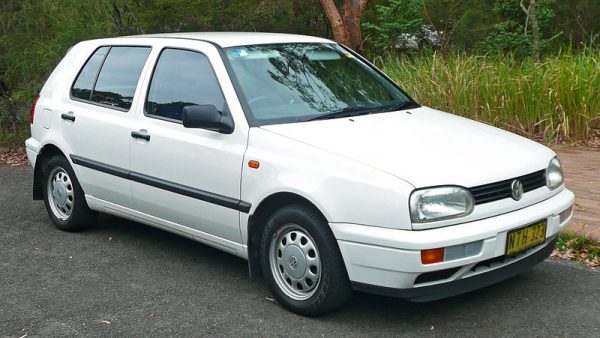

For the first time "Golf" is stylized as an external design and interior design using the names of the popular bands Rolling Stones, Pink Floyd, Bon Jovi. In this way, the company applied a marketing ploy when selling individually modified vehicles.


Changes to the active safety of the Golf III were made at the design stage. The interior has been reinforced to prevent deformation of the front side elements under load, the doors are resistant to penetration, and the rear seat backs are protected from the load in a collision.
Photo gallery: VW Golf III
-


- Exterior Golf 3 after restyling changed for the better
-


- The angular design of the first versions was replaced by the smooth rounded shapes of the Golf 3
-


- Improved aerodynamics of the Golf 3 gives the model a bold character
-


- Comfortable interior Golf 3 does not need a spacious trunk
-


- The optimized driving position in the Golf 3 ensures complete driving comfort
Fourth generation Golf IV (1997–2003)
The main feature in the design changes in 1997 was the fully galvanized body. The model has improved appearance and interior decoration. Upholstery, instrument panel, steering wheel and switches were offered in updated quality. An unusual detail was the blue illumination of the instrument panel. All versions were equipped with ABS and airbags.
Video: 1997 VW Golf
The overall appearance of the interior set the standard for quality in the personal vehicle class. Golf IV is made soundly and can count on the attention of competitors. Large wheels and a wide track give confidence when driving. The headlights and grille are modern in design, and the entire bumper area is fully painted and integrated into the bodywork. While the Golf 4 looks longer than the Golf 3, it lacks rear legroom and boot space.
Since the fourth generation, an era of complex electronics has been introduced, often presenting special problems that require the help of specialists in repairs.


In 1999, VW adopted a fine atomization engine, achieving stable engine performance and reduced fuel consumption. The strengths of the model were the succession of smooth lines of the body and the unsurpassed design, raising the "Golf" to the level of a premium class.
Basic modification includes:
- four airbags;
- xenon headlights;
- Rain sensor;
- navigation system;
- auto-dimming rearview mirror;
- Isofix child seat anchors.


The continuously implemented development strategy of the Golf platform has enabled efficient production and reduced development costs for new models. The main engine type was a 1,4-liter 16-valve aluminum engine. As an attractive element, the company introduced a 1,8 turbo engine with 20 valves in 150 hp. With. The V6 was available in combination with a new, electronically controlled 4Motion all-wheel drive system and an advanced Haldex clutch used in conjunction with ABS and ESD. The power of the box was distributed as 1:9, that is, 90 percent of the engine power is sent to the front axle, 10 percent to the rear-wheel drive. The V6 was the first Golf to come with a six-speed transmission and the world's first production dual-clutch DSG. The diesel segment has experienced another breakthrough with new fuel nozzle technology.
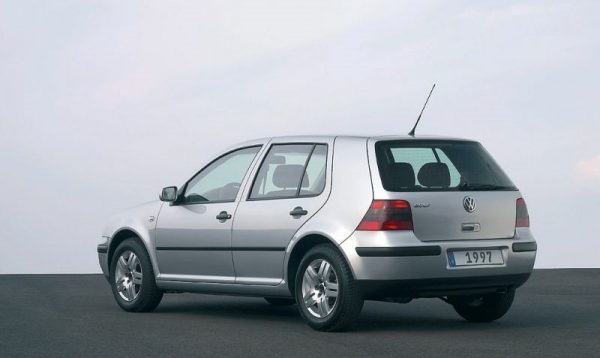

Volkswagen celebrated the new millennium with the 20 millionth Golf.
Photo gallery: VW Golf IV
-


- The attractive appearance of the fourth generation VW Golf differs from previous versions
-


- State-of-the-art, next-generation LED technology ensures safe travel
-


- The interior of the model's cabin raises the bar of quality to the level of premium
-


- Comfortable placement of the driver behind the workplace gives confidence when moving
Fifth generation Golf V (2003–2008)
When the facelift was launched in 2003, the Golf V fell short of VW's expectations. Customers backed off initially, in part because the installation of an indispensable air conditioner was offered as an additional expensive option, although the Golf V stood out for its technical condition and quality indicators.
In 2005, VW continued its sports car concept for more demanding customers with the introduction of the Golf V GTI with a new level of dynamic styling, significantly increased rear passenger space and a comfortable driving position with comfortable and ergonomic controls.


The faint raspy sound of the GTI distinguished the two-liter turbocharged engine under the hood, producing a powerful torque of 280 N/m and 200 hp. With. with the best power to weight ratio.
Video: 2003 VW Golf
The chassis has undergone significant changes in the front struts, a new four-way axle has been used in the rear. This model offers an electromechanical power steering, six airbags. A 1,4-liter aluminum engine with 75 horsepower is standard. with., which has established itself as the most popular type of power unit.
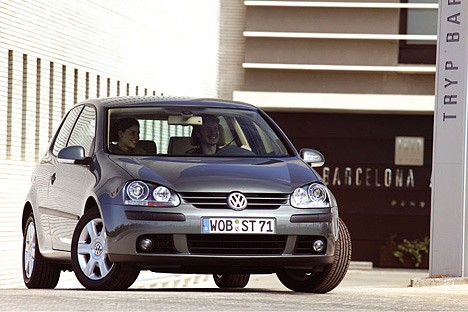

The release of the fifth generation Golf attracted the central location of twin exhaust pipes and oversized blue calipers.
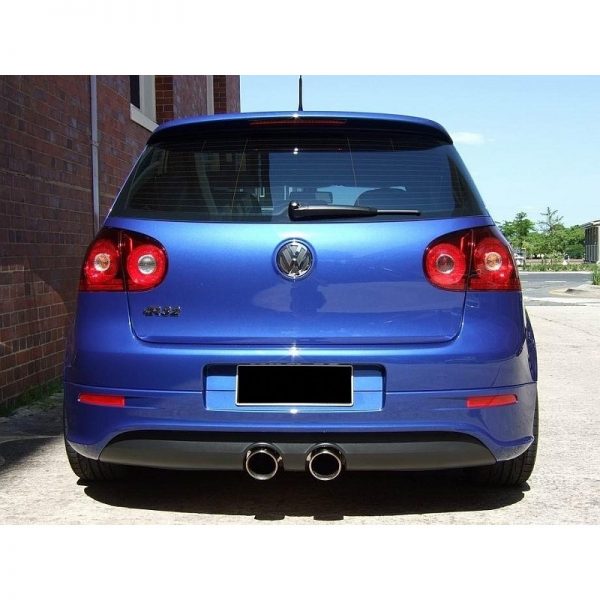

Volkswagen continues to produce interiors characterized by functionality, tangible quality and a high level of visual aesthetics. Optimal use of space has increased rear legroom. This optimized seating ergonomics and significantly improved interior space convinced buyers of the perfection of the updated version of the Golf.


Behind the individual interior elements was an innovative technology for maximum comfort and essential ergonomic features with optimal adjustment ranges for the length and height of the front seats with automatic reclining. Volkswagen is the first manufacturer to offer electric 4-way lumbar support.
Photo gallery: VW Golf V
-


- A notable feature of the VW Golf 5 was the elegant opportunity to open the trunk for the emblem
-


- Smooth car exterior hides innovative technology and functionality
-


- New-generation model with improved aerodynamics following major body design changes
-

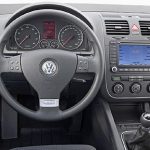
- The ergonomic layout of the controls meets the expectations of motorists in terms of comfort
-


- Informative dashboard VW Golf with on-board computer reflects the technological functionality of the model
Sixth generation Golf VI (2008–2012)
The launch of the Golf VI continues the successful history of the classic trendsetter in the automotive world. At first glance, he seemed more flamboyant, muscular and taller in his segment. The Golf 6 has been redesigned front and rear. In addition, the interior design, updated optics and styling exceeded the capabilities of the presented class.
Video: 2008 VW Golf
For safety, the sixth Golf was equipped with standard knee airbags. The Golf is now equipped with Park Assist and an automatic security system with remote engine start. New measures have been taken to reduce noise, and the acoustic comfort of the cabin has been improved through the use of an insulating film and optimal door sealing. From the engine side, the modification began with 80 hp. With. and a new seven-speed DSG.
Photo gallery: VW Golf VI
-


- The combination of good looks and aerodynamics contributed to the continued success of the model.
-


- In the new model, the layout of the light elements has been changed to attractive rounded outlines
-

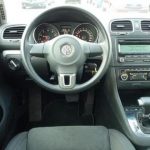
- Optimal arrangement of controls using innovative technologies and modern materials
-

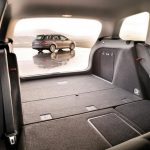
- The impressive dimensions of the luggage compartment with the rear seats folded down allow you to carry large loads
Seventh generation Golf VII (2012 - present)
The seventh evolution of the Golf introduced a completely new generation of engines. The 2,0 liter TSI delivers 230 hp. With. in combination with an improved package that affects the performance of the motor. The sports version offered 300 hp. With. in the Golf R version. The use of a diesel engine with direct fuel injection and supercharging provided up to 184 hp. with., consuming only 3,4 liters of diesel fuel. The start-stop function has become a standard system.
Video: 2012 VW Golf
Key features of every Golf VII include:
- seven airbags;
- electronic stabilization system (ESC);
- electronic parking brake with automatic hold function;
- side differential lock XDS;
- recovery mode.
In November 2016, the Golf received both exterior and interior changes with a host of technical innovations, including the use of a new "Discover Pro" information system with gesture control. A slight increase in dimensions, as well as an extended wheelbase and track, had a noticeable effect on the increase in interior space. Width changed by 31mm to 1791mm.
The successful space concept of the new Golf provides many other improvements, such as a 30-litre increase in boot space to 380 liters and a 100 mm lower loading floor.
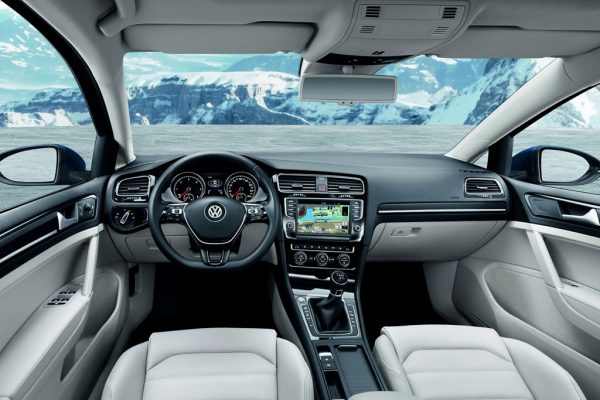

Design and operation:
- spacious and ergonomic 12-position driver's workplace with a high level of practicality and functionality, equipped with 2-sided lumbar support for the front seats;
- wide range of steering wheel adjustments;
- optimized distance between the brake and accelerator pedals increased by 16 mm;
- a plus in terms of ergonomics was a raised gear knob;
- touch screen with three main buttons and rotary controls located on the center console;
- touch screen device with proximity sensors.
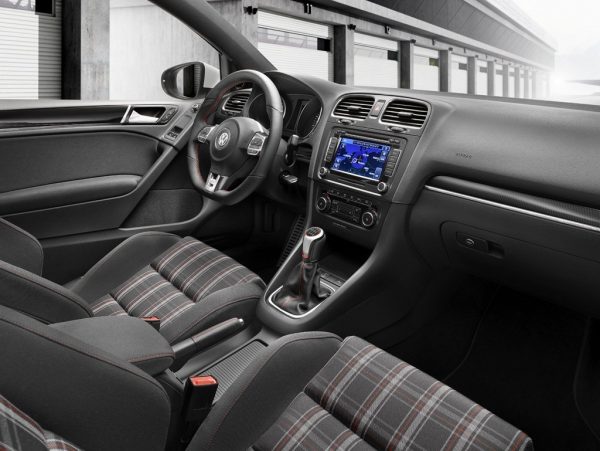

Table: comparative characteristics of the Volkswagen Golf model from the first to the seventh generation
| Generation | first | Second | The third | Fourth | Fifth | Sixth | Seventh |
| Wheelbase, mm | 2400 | 2475 | 2475 | 2511 | 2511 | 2578 | 2637 |
| Length, mm | 3705 | 3985 | 4020 | 4149 | 4188 | 4204 | 4255 |
| Width | 1610 | 1665 | 1696 | 1735 | 1740 | 1760 | 1791 |
| Height, mm | 1410 | 1415 | 1425 | 1444 | 1440 | 1621 | 1453 |
| Air drag | 0,42 | 0,34 | 0,30 | 0,31 | 0,30 | 0,304 | 0,32 |
| Weight, kg | 750 – 930 Feet | 845 – 985 Feet | 960 – 1380 Feet | 1050 – 1477 Feet | 1155 – 1590 Feet | 1217 – 1541 Feet | 1205 – 1615 Feet |
| Engine (gasoline), cm3/l. from. | 1,1 – 1,6 / 50 – 75 | 1,3 – 1,8 / 55 – 90 | 1,4 – 2,9 / 60 – 90 | 1,4 – 3,2 / 75 – 241 | 1,4 – 2,8 / 90 – 115 | 1,2 – 1,6 / 80 – 160 | 1,2 – 1,4 / 86 – 140 |
| Engine (diesel), cm3/l. from. | 1,5 – 1,6 / 50 – 70 | 1,6 Turbo/54–80 | 1,9 / 64-90 | 1,9 / 68-320 | 1,9/90 | 1,9 / 90-140 | 1,6 – 2,0 / 105 – 150 |
| Fuel consumption, l/100 km (gasoline/diesel) | 8,8/6,5 | 8,5/6,5 | 8,1/5,0 | 8,0/4,9 | 8,0/4,5 | 5,8/5,4 | 5,8/4,5 |
| type of drive | front | front | front | front | front | front | front |
| Tire size | 175 / 70 R13 185/60 HR14 | 175 / 70 R13 185 / 60 R14 | 185/60 HR14 205/50VR15 | 185/60 HR14 205/50VR15 | 185/60 HR14 225 / 45 R17 | 175 / 70 R13 225 / 45 R17 | 225 / 45 R17 |
| Ground clearance, mm | — | 124 | 119 | 127 | 114 | 127/150 | 127/152 |
Features of models running on gasoline and diesel fuel
In September 1976, Golf Diesel became the main innovation in the compact car segment in the German market. With a consumption of about 5 liters per 100 kilometers, Golf Diesel wedged itself into the line of economical vehicles of the 70s. In 1982, the diesel engine was equipped with a turbocharger, which showed remarkable performance and the title of the most economical car in the world. With the new exhaust silencer, the Golf Diesel is quieter than its predecessor. The performance of the most powerful version of the Golf I 1,6-liter engine was comparable to the sports supercars of the 70s: the maximum speed was 182 km/h, acceleration to 100 km/h was completed in 9,2 seconds.
The structure of the combustion chamber shape of diesel engines is determined by the course of formation of the fuel mixture. In the short time of creating a mixture of fuel and air, the ignition process begins immediately after injection. For complete combustion of the fuel medium, the diesel must be completely mixed with air at the moment of maximum compression. This requires a certain volume of directional air flow so that the fuel is completely mixed during injection.
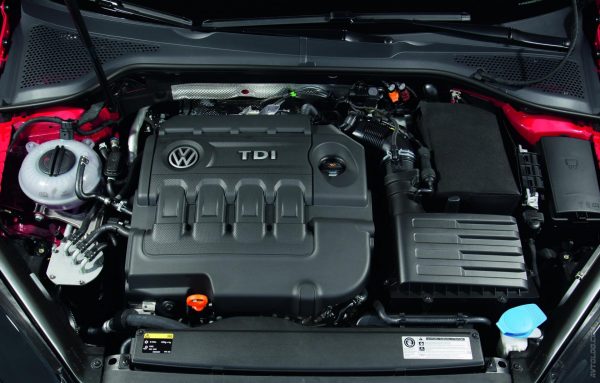

Volkswagen had good reasons for introducing a diesel engine in new models. The Golf's market launch came at the time of the oil crisis, demanding fuel-efficient and reliable engines from manufacturers. The first Volkswagen models used a swirl combustion chamber for diesel engines. A swirl combustion chamber with a nozzle and a glow plug was created in the aluminum cylinder head. Changing the location of the candle made it possible to reduce fuel consumption by reducing the smoke of gases.
The components of a diesel engine can withstand a higher load than a gasoline engine. Although, the size of a diesel engine was no larger than a gasoline one. The first diesels had a volume of 1,5 liters with a capacity of 50 liters. With. Two generations of Golf with diesel engines did not satisfy motorists with either economy or noise. Only after the introduction of a 70-horsepower diesel engine with a turbocharger did the noise from the exhaust tract become more comfortable, this was facilitated by the use of an insulating partition in the cabin and noise insulation of the hood. In the third generation, the model was equipped with a 1,9-liter engine. Starting in 1990, a 1,6-liter turbodiesel with an intercooler and 80 hp was used. With.
Table: Fuel prices during the production period of VW Golf models (Deutsch brands)
| Year | Petrol | Diesel |
| 1974 | 0,82 | 0,87 |
| 1983 | 1,32 | 1,28 |
| 1991 | 1,27 | 1,07 |
| 1997 | 1,62 | 1,24 |
Volkswagen Golf 2017
The updated Volkswagen Golf 2017 is aimed at the use of high-quality equipment and a distinct exterior design. The front end features a sporty chrome-finished grille and signature emblem. Elegant contours of the body and LED taillights distinguish the model from the general stream.
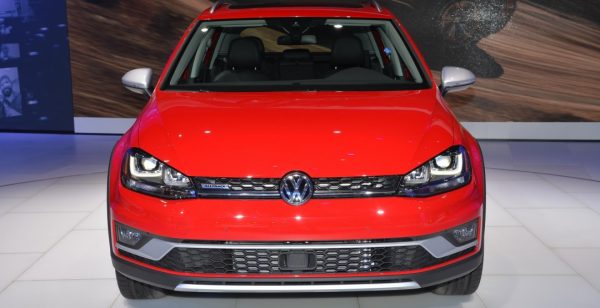

Since the date of the first presentation, the Golf has been one of the favorite cars, thanks to its exceptional dynamics, design, practicality and affordable price. Motorists positively evaluate the soft running of the chassis, the control precision and the acceptable package in the basic configuration:
- heated front seats;
- keyless access;
- start from the button;
- standard active safety features;
- rain-sensitive windshield wipers;
- frontal collision warning;
- autonomous emergency braking;
- automatic control of the distance to the vehicle in front;
- blind spot warning system.
Video: 7 Volkswagen Golf 2017 test drive


Watch this video on YouTube
The Golf has set a first-rate quality standard with additional features in its class. The Volkswagen lineup continues the family of compact cars with front-wheel drive and AllTrack all-wheel drive. Trim levels are available on new models with the Driver Assistance Package, which includes Light Assist. New for 2017 is the standard, all-wheel drive 4Motion, with attractive ground clearance Golf Alltrack.
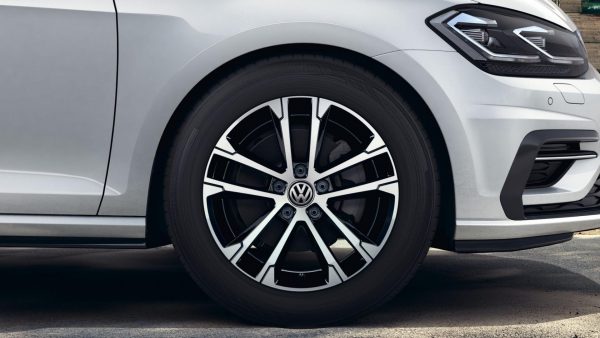

Regardless of body style, the new Golf offers generous interior space with reclining and cozy rear seats and a new infotainment system. In the interior, the Golf uses straight lines and soft colors.
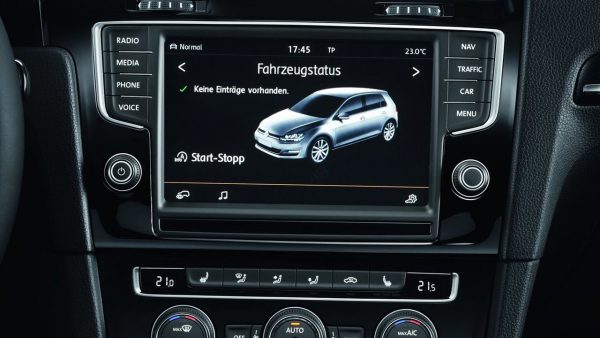

Comfortable cabin space is defined by generous proportions to comfortably accommodate the driver and passengers. Ergonomic seats allow optimal driving control with a central panel slightly inclined towards the driver.
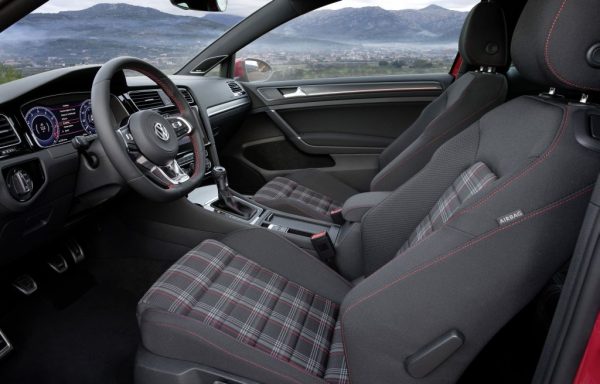

Updated corner headlights and a rear window sharpen the look. Small proportions, a short hood and spacious windows contribute to everyday use. The LED daytime running lights are complemented by LED fog lamps, which determine the visibility of vehicles in adverse operating conditions. Standard headlight settings have a sufficient range of adjustment, compensating for different load patterns.
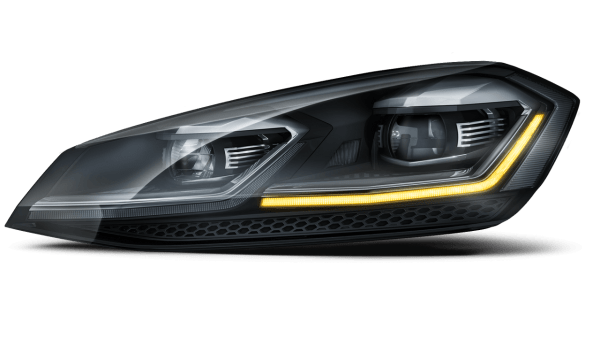

The sporty spirit is felt in the design of the door sills, stainless steel pedals, floor mats with decorative stitching. The multifunction sports steering wheel made of leather with modern design inlays completes the aesthetic impression of a dynamic character.
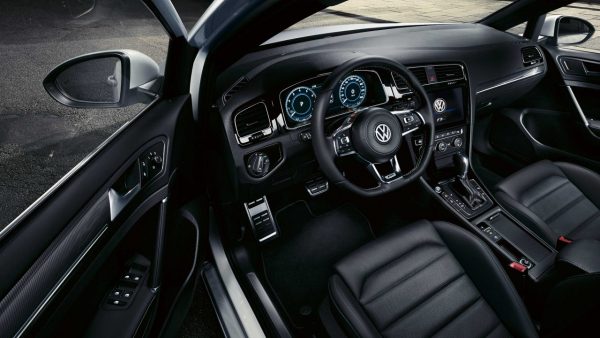

Security is the strength of the company. In crash tests, the Golf received an overall score of five stars. With its advanced safety features, it is named Top Safety Pick with good marks in all tests. Active safety features are basic for all model versions. Special attention deserves the function of emergency braking in city traffic when driving at low speeds to detect obstacles within the system's coverage area if a pedestrian suddenly appears on the road.
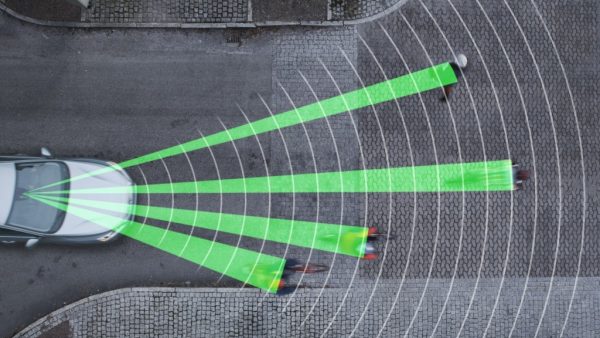

The Volkswagen Group wants to become a world leader in the automotive industry, increasing production of all brands to push other market leaders from the top of sales. The main idea of the company is to expand the current investment planning for the modernization and renewal of the range of all brands of the group.
Owner feedback
The Volkswagen Golf2 hatchback is a real workhorse. For five years, 35 rubles were spent on car repairs. Now the car is already 200 years old! Body condition has not changed, except for new paint chips from stones on the track. Golf continues to gain momentum and delight its owner. Despite the state of our roads. And if we had roads like in Europe, then the final amount can be safely divided by two. By the way, the wheel bearings are still running. That's what quality means.
The Volkswagen Golf7 hatchback is good not only for city trips, but also for long trips. After all, he has a very small consumption. We often go to the village 200 km from the city and the average consumption is 5,2 liters. It's just wonderful. Although gasoline is the most expensive. The salon is very spacious. With my height of 171 cm, I sit absolutely freely. The knees do not rest against the front seat. There is plenty of room in the back as well as in the front. The passenger is absolutely comfortable. The car is comfortable, economical, safe (7 airbags). The Germans know how to make cars - that's what I can say.
Reliable, comfortable, proven car in good technical and visual condition. Very dynamic on the road, well managed. Economical, big plus low fuel consumption. Despite its age, it fully meets all the requirements: power steering, air conditioning, ABS, EBD, interior mirror lighting. Unlike domestic cars, it has a galvanized body without rust.
Since its inception, the Golf has been regarded as a reliable everyday driving vehicle with innovative driving characteristics. As the ideal vehicle for every stakeholder group, the Golf has set new standards for the automotive industry. At the moment, the German concern is introducing modern technologies into the production of a new concept of the ultra-light hybrid Golf GTE Sport.








